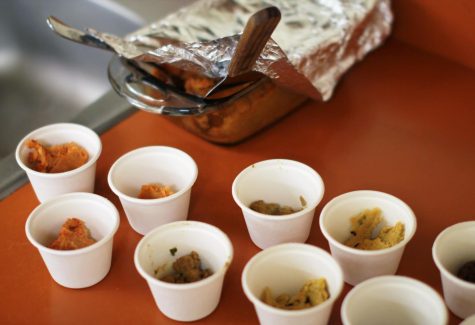Food co-op hosted plant protein workshop
Monthly classes teach how to buy a cheap, healthy diet
MICHAEL LINDER | The Daily Evergreen
Students and community members listening to a “Healthy Eating on a Budget” presentation Saturday evening at the Latah County Fair Office in Moscow.
October 4, 2017
The Moscow Food Co-op five-part class, “Healthy Eating on a Budget,” promotes making better decisions about food while saving money.
Classes take place monthly, with a different theme for each class. Saturday’s class, titled “Proteins,” was the second in the series and featured the affordability of plant proteins such as lentils, beans and chickpeas, as well as how to prepare them.
Alice Ma, WSU Dining Services dietician and instructor of the class, led a presentation showcasing five plant-based recipes and weekend preparation tips designed to save time throughout the week.
“A lot of people think they can’t afford to eat healthy because some of the ingredients may seem more expensive than eating processed food or frozen dinners,” Ma said.
Guests sat at a row of foldable tables and chairs in the classroom as Ma gave her presentation. Samples of the recipes in white paper cups lined the counter toward the right of the room. Each participant received a fork upon entering the classroom.
Dried beans purchased in bulk cost much less than canned beans, Ma said. Whereas one can of garbanzo beans can cost about $1.49 and yield less than two cups, one pound of dried beans costs $1.34 at the Moscow Food Co-op and yields about six cups when cooked.
Cooked beans can last three to five days or more in the fridge, so they last very well throughout the week, Ma said. This saves time on weekdays because of the bean’s versatility, like in the garbanzo bean loaf, as sampled in class.
Ma then introduced nutritional yeast to the class, holding up a small plastic container of a yellow, flakey powder.
Nutritional yeast differs from baking yeast used in breads, Ma said. It tastes like cheese and has many uses. For example, it can be sprinkled on popcorn as a seasoning.
Even though nutritional yeast might seem expensive, it’s very light and people only need to use a little, she said. It also makes a good replacement for cheese in dishes like macaroni and cheese.
Max Newland, co-op education and events coordinator, passed out samples of the garbanzo bean loaf as Ma introduced the recipe to the class.

Ma prepared plant-based protein samples for attendees.
A single pan of bean loaf freezes well and serves six people. With ingredients purchased at the co-op, a six-serving pan can last throughout the week for lunch or dinner at 90 cents per serving, Ma said.
Chickpea curry with sunflower butter came next. The sunflower butter is a substitute for peanuts for allergies. This dish pairs well over rice, she said. Three servings total 90 cents.
The next slide in the PowerPoint illustrated a few other ways to use beans and lentils in cooking, such as breading for chicken nuggets or swapping out lentils in bean dishes.
Chickpea flour, often used in Indian recipes, contains about 10 grams of protein per half cup and can replace whole-wheat flour in baking, Ma said.
Black salt, another Indian ingredient, smells like eggs and can mimic the taste in dishes. Ma passed around a jar of the salt for participants to smell for themselves, while Newland passed out the omelet samples.
A one-to-one ratio of chickpea flour and water with a pinch of black salt can make an omelet, Ma said. The black salt gives it that egg taste.
Ma presented a protein-rich dessert: chickpea cookie dough bites, which have the texture of cookie dough without the raw egg.
“I personally just like desserts,” Ma said. “I think people want to eat them more regularly, and there isn’t really a ‘dessert on a budget’ class that exists or that I’ve seen.”

Co-op employee hands out sample cups for attendees of the healthy foods discussed in the workshop.
Each “bite” costs 17 cents, although people typically eat more than one bite at a time, she said.
No-bake nut butter oat bars, similar to granola bars, are made with just three ingredients and concluded the recipe list. This recipe utilizes ingredients already on-hand with many combinations to choose from, such as honey or maple syrup with peanut butter or sunflower butter.
Calculating total costs of the ingredients in the dishes she prepared, Ma spent $13.81 on 11 entrees and 22 snack servings. Then, looking at the protein content, a day’s worth of just these foods contains 54 grams or up to 70 grams with the inclusion of side dishes to meals.
The Moscow Food Co-op asked Ma to teach these classes about a year ago, she said. They are designed to end the stigma that shopping at the co-op, or just eating healthy, is too expensive. The overall goal is to teach easy recipes so people can eat healthier, she said.
Ma said she finds all of her recipes on Pinterest. If she finds a recipe that looks like it can be made cheaply, is allergen-friendly, has few ingredients and is easy to prepare, she pins it for later. Most of those ingredients can be found in bulk at the co-op, so they are also fairly inexpensive.
The main food groups, with the addition of a separate dessert category, make up the class themes, she said. And by request, the last class in the series will focus specifically on meal planning, finding coupons and deals, and will include a tour of the bulk section of the co-op.
“One of the seven cooperative principles that all co-ops operate by is education. We want to make sure we’re known for that,” Newland said, “that you could take a class on fun easy ways to cook meals that don’t cost a lot of money.”
Community members and students can register for the next class on Oct. 28, which will be about fruits and vegetables. The registration fee is $5, but will be reimbursed with a gift card to the co-op when attending the class. Walk-ins are also welcome, but registration in advance is encouraged. More information is available on the co-op website.
Correction: This article has been revised to reflect that the protein content in a day’s worth of all five recipes contains 54 to 70 grams, not 34 to 70 grams.









